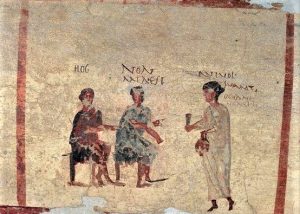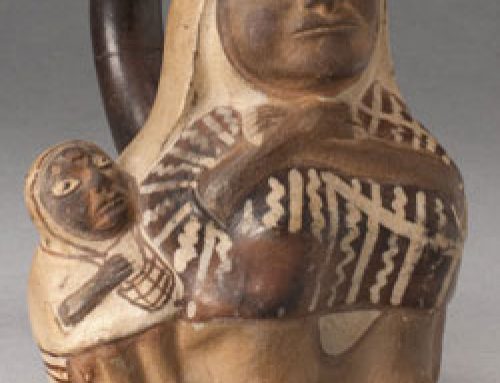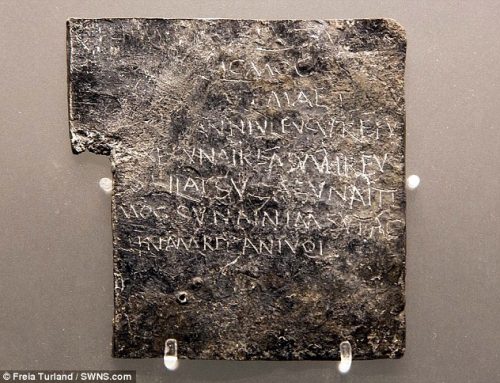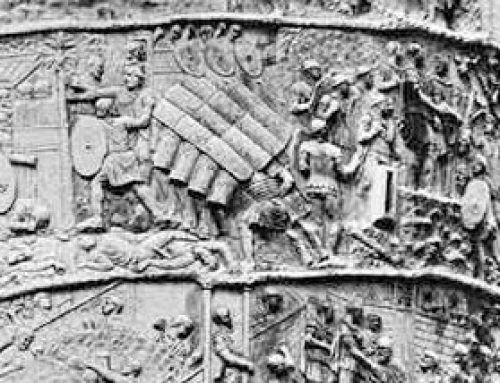
Roman women: an old woman, about 50 AD. The sculptor has made her look silly on purpose to make fun of old women
Were women oppressed in ancient Rome?
Roman women lived under many restrictions that did not apply to Roman men. Roman women knew that men were treating them unfairly, and they did not like living under special rules.
We can see that from this speech that Livy says Cato made in the Senate in 195 BC:
“This is the smallest of the injunctions laid on them by usage or the laws, all which women bear with impatience: they long for liberty; or rather, to speak the truth, for unbounded freedom in every particular.” (Livy 34.2.13-14).
Roman law treated women badly.
Roman women didn’t get equal rights with men. The law insisted that women could not be emperors, or be in the Roman Senate, or govern a province, or join the army. Men could beat or rape their wives, just as they beat and raped their slaves.
(Read more about slavery in ancient Rome)
A Roman woman could divorce her husband, but generally he kept the children. Women who were slaves were frequently physically and sexually abused, and often saw their children killed or sold away from them.

Roman women: Tombstone of Septimia Stratonice, a shoemaker about 100 AD
Women’s rights in ancient Rome
On the other hand, Roman women did gain some rights that other women living at the same time did not have. At least some Roman girls were able to go to school, and some women continued to college-level educations.
(More about school in ancient Rome)
When women got married, they were still technically under the power of their fathers and not their husbands. So their husbands had no legal right to make them do anything. Women didn’t take their husband’s name, either.
(More about families in ancient Rome)
After their fathers died, Roman women could act completely independently. Unlike Greek women, Roman women had the right to inherit their parents’ property equally with their brothers.
(More about the history of inheritance)

A barmaid brings a drink to two men sitting on chairs. The words show the men arguing about whose drink it is. (Caupona of Salvius, Pompeii, 79 AD)
With their inheritance, they could start businesses and own property.Roman women could write their own wills, too. They could choose to leave their property to whoever they wanted; they could choose to favor one child over another, or to leave their business to their partner instead of to their children.
Women’s work in ancient Rome
Their jobs were not that different from the jobs women have today, except that women were not generally school teachers. There were women in ancient Rome who were shoemakers and seamstresses, pharmacists and bakers. Many women worked as midwives or wet nurses.
(More about wet nursing)
Many other women worked as waitresses in restaurants and fast food joints. Some women were professors at universities, or doctors.
Women and farm work

Child’s wool sock – nalbinding (Oxyrhynchus, Egypt, 100s AD)
Like men, many women did farm work. Women planted seeds. They weeded with long hoes. Women didn’t generally scythe the grain, but they stacked it to dry. By the time of the Roman Empire, most people probably had their flour ground at larger mills. So most women didn’t grind grain into flour at home anymore. That must have been a relief!
Women and textile work
Many women in ancient Rome worked in the textile industry, making wool and linen cloth.
(More about linen cloth)
Mostly, by this time, women didn’t make the clothes for their own families at home. People bought their clothes in stores. Instead, women worked at home doing piecework, or in textile factories, spinning and weaving to make cloth to sell. Some of these factories belonged to the government. Probably women also did a lot of nalbinding – a kind of early knitting.
Wool and linen cloth were important export items for the Romans. Traders sold wool and linen cloth on the Silk Road in order to buy silk, Indian medicines, and steel tools.

Women in ancient Rome: The Roman empress Julia Maesa
Political power for Roman women
Despite their disadvantages, some Roman women also managed to get political power. Once in a while, Roman women served on their local town council.
Messalina and Agrippina
At the very top of the Roman political structure, Messalina and Agrippina the Younger more or less had control of the Roman Empire for a few years in the first century AD.
(More about Agrippina the Younger)
The Severan Women

The Roman empress Pulcheria
Another occasion where women were able to get power in ancient Rome came a hundred and fifty years later. Beginning in 217 AD, Julia Maesa and Julia Mamaea ruled the Roman empire through their grandsons and son until 226 AD.
(More about the Severan women)
Pulcheria and Galla Placidia
It took another two hundred years for women to get into power again. The empress Pulcheria kept control of the eastern Empire from 414 to her death in 453 AD. And her niece Galla Placidia controlled the western Empire for several years as well.





when did you realease and last update this i cant find the dates via the website and need it for an important assignment in my class please help me out thanks
Sorry you had trouble, Lily! That information is in the “Cite this page” box right at the end of the article, above the author bio: Cite this page: Carr, K.E. Roman women: Women in ancient Rome – gender and power. Quatr.us Study Guides, September 4, 2017. Web. August 8, 2018.